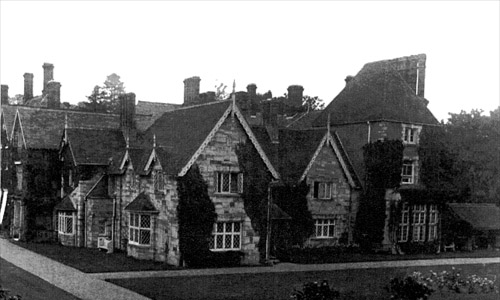Isenhurst Manor
Sussex
| Location | nr. Heathfield | ||
| Year demolished | 1950s, 1970s, 1990s | ||
| Reason | Abandoned then fire then replaced by housing | ||
| See all images: | Gallery | ||
| << Back to the main list |
The lands around Isenhurst belonged to the Priory of Michilham having been donated to the priory in 1281 by Thomas and Joan de Burton. In 1537 the priory was dissolved and Henry VIII granted the "the house and site of the suppressed Priory of Michelham, Sussex, and also the lordships and manors of Michelham...Isenhurst...The Water mill in Mafeld...and land and tenements elsewhere belonging to the said late priory, in as full a manner as the late prior held the same."1
 With Cromwell's fall in 1540 the King granted the lands to Sir Richard Sackville but he only held it for four years before selling it in 1544 to Sir John Baker, the Attorney-General, who in 1542 had been previously rewarded by the King with extensive lands elsewhere in Sussex. Isenhurst then passed through the Mayfield branch of the Baker family coming to the Rev. John Kirby in 1831. He sold it in 1842 to Morgan Thomas Esq (b. ? - d. 1867) who took the name Treherne when he married into the wealthy Treherne family of Bridgend, Wales. Treherne became an MP holding the two-seat constituency of Coventry firstly with Sir Joseph Paxton between 1863-65 and then Henry Eaton, 1st Baron Cheylesmore between 1865-67.
With Cromwell's fall in 1540 the King granted the lands to Sir Richard Sackville but he only held it for four years before selling it in 1544 to Sir John Baker, the Attorney-General, who in 1542 had been previously rewarded by the King with extensive lands elsewhere in Sussex. Isenhurst then passed through the Mayfield branch of the Baker family coming to the Rev. John Kirby in 1831. He sold it in 1842 to Morgan Thomas Esq (b. ? - d. 1867) who took the name Treherne when he married into the wealthy Treherne family of Bridgend, Wales. Treherne became an MP holding the two-seat constituency of Coventry firstly with Sir Joseph Paxton between 1863-65 and then Henry Eaton, 1st Baron Cheylesmore between 1865-67.
Treherne lived in at the Gatehouse at Isenhurst which was thought to be part of the original manor house complex. It was behind this house that the original, larger, Isenhurst manor had been sited as there were outlines and foundations visible on the ground though this had been long gone when Thomas arrived and, by 1903, there were only remains of the Gatehouse. Treherne was obviously dissatisfied with the Gatehouse and so started to construct the house in the first photo in the Gallery by adding to an existing old farmhouse. This was a familiar route for Treherne who, in 1830, had carried out extensive alterations and had added to his wife's family home Bryngarw House in Bridgend, which had originally been a farmhouse. Photos of Bryngarw today show a distinct similarity with the design and style of Isenhurst Manor, possibly indicating that Treherne was his own architect.
The building was extensive and had huge wine cellars, stables, cottages, staff accommodation and a chauffeurs cottage (the old car was still inside the garage in the 1980s!). Following Morgan Treherne's death in 1867, his widow, Louise, moved out of a house now much too large for her and back into Gatehouse and the property was sold - in the same year it is listed as the seat of Sir Frederick Sykes, Bart.2. By 1874 it was listed as the seat of Sir George Rendlesham Prescott, Bart., who held until it his death in 1894.
Isenhurst was sold sometime in the early 20th century as the owner between the wars was a Lt. Col. Hardy. No further details can be found until the late 1930s when it was used for film-making and featured in the film 'Four Feathers' (1939). During World War II it was requisitioned and various companies of troops were stationed there including the 1st Battalion Worcestershire Regiment in June 1944 and the Royal Army Service Corp also in the same year. The use by troops probably left the house in a decrepid state though it was still complete but it appears to have been abandoned after the war.
With no occupation the house quietly mouldered away until 1985 when it was deliberately set alight. The fire damaged the great hall and the upper floors which led to the demolition of most of the house except for the central core of the house and some outer walls. Interestingly the house was partially of concrete construction, primarily for the floors, most likely as a fire precaution. The ruins were subsequently demolished in the late 1990s and site built over with luxury homes.
Sources:
Information and images kindly supplied by R. Fisher. The image c1925 is © the Derry Collection.
1 'Mayfield - The Story of an Old Wealden Village' - Elizabeth Margaretta Bell-Irving (William Clowes & Sons, 1903)
2 'Kelly's Post Office Directory of Essex, Herts, Middlesex, Kent, Surrey and Sussex' (1867)